If you save money by eating in your truck, you may appreciate some food storage ideas to help you keep your foodstuffs organized, tidy and as fresh as possible.
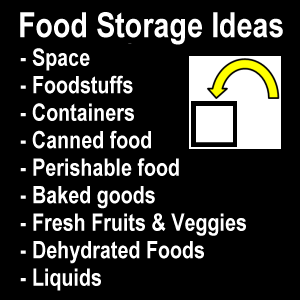 Here are ways that we have kept foods in our trucks over the years.
Here are ways that we have kept foods in our trucks over the years.
Disclaimer: The only brand of long haul trucks we have ever driven in which to store food has been a Freightliner. We are not familiar with the storage room in other makes of tractors.
Space
Considering the space in your truck, you may have room for food storage
- under the lower bunk (assuming you have an upper and lower bunk in your truck),
- some cabinet space (either open, behind cargo nets or behind actual doors), and
- some floor space (either in front of or behind the passenger seat).
The photograph below shows numbered articles we packed in our truck at one time (lower bunk is up, showing storage room beneath):
1. shower bag;
2. small crock pot;
3. electric skillet;
4. inverter;
5. foods: canned, bagged and boxed;
6. foodstuffs on top of a microwave oven;
7. gallons of water;
8. portable toilet; and
9. space for an ice chest.
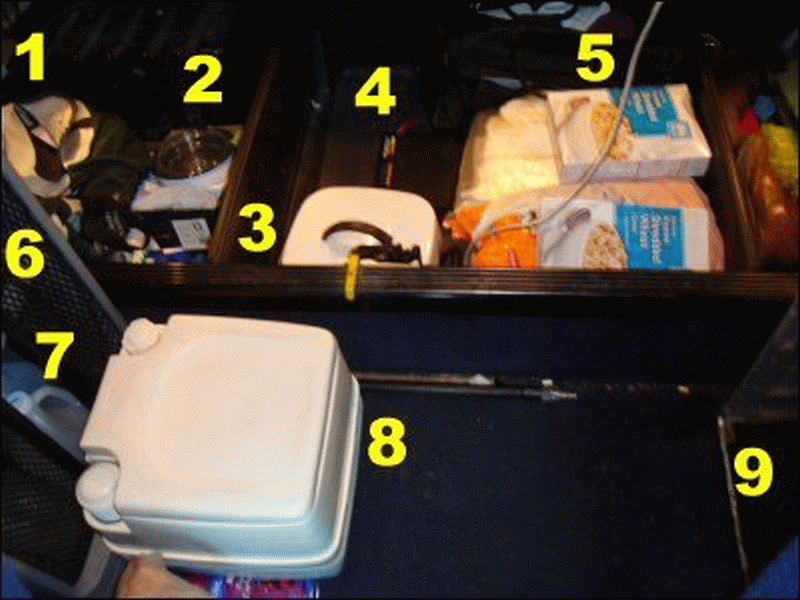
Foodstuffs
Considering the foodstuffs that you want to take with you on the road, you may have
- perishable food that requires being kept cold;
- perishable food that can remain (at least for awhile) at room temperature; and
- non-perishable food that can be stored just about anywhere.
Obviously, perishable food that requires being kept cold must be kept in a cold food storage device such as an ice chest, refrigerator or thermoelectric cooler.
Foods in this category include meats (raw or cooked), dairy products (eggs, cheese, milk, yogurt, etc.), some fresh produce and some prepared foods.
Some foodstuffs can be kept in sealable containers (like Rubbermaid, Tupperware, etc.), such as these from Amazon.com, with whom we have an affiliate relationship.
These include rice, brown sugar, potato flakes, dry skim milk powder, and our homemade hot chocolate mix.
We have stored white granulated sugar and Bisquick in larger containers like those shown, except we pour the foodstuffs directly in the clean containers (instead of keeping the bags inside).
Cereals should also be kept as airtight as possible to keep from going stale or absorbing moisture.
This includes hot cereals (grits, Cream of Wheat, quick cook oats, etc.) and cold cereals.
Malt-O-Meal® cereals come in their own sealable bags, which makes resealing very convenient.
Food-grade sealable plastic bags are good for food storage for other types of non-perishable dry foods like popcorn, sunflower kernels, nuts, dry beans and dry peas.
We store saltine type crackers in their original plastic sleeves and use a twist tie to close sleeves that we have previously opened.
Pasta can generally be kept in original boxes.
Spices can be kept in their original containers although some may be prone to clumping (especially garlic powder and onion powder).
Food Storage Container Tips
It is very helpful if food storage containers:
- do not have much slope to their sides (especially the large ones, for maximum storage space within);
- have the same or nearly the same dimensions so that they can be stored near each other; and
- can be stacked neatly one on top of the other or next to each other.
It is also helpful if
- empty containers can nest inside each other and
- loose lids will snap onto each other (instead of just being loose).
We chose to buy the Rubbermaid food storage set shown here and it is one of the best sets of food storage containers we have ever bought.
The lids snap onto the bottom of the bowls when empty and nest together perfectly when placed together.
Not only that, but we experimented to see how airtight the lidded bowls were.
After “burping” the air out of the container with its lid, we submerged it in the icy cold water in our ice chest.
After having been there a number of hours, we noticed no leakage whatsoever. Very nice!
(Note: plastic bowls and lids like those shown here may not be microwave-safe. Let the buyer and user beware.)
Canned Food
If you are the kind of driver who doesn’t mind eating canned foods, you can have many meals made quickly by just opening cans and heating the contents.
Just make sure that the cans are stored in your truck so that they don’t fall over or roll around.
Some drivers are fortunate to have their home support teams preserve foods through a canning process in glass canning jars.
We have found it convenient to store metal cans and glass canning jars in a plastic bin under the lower bunk.
Not only does this limit their movement, but prevents problems in the unlikely event that a can bursts or jar breaks.
Furthermore, it is easier to move a sturdy under-the-bed type bin containing canned goods (assuming it’s not too heavy) than having to pack them up and move them in plastic grocery shopping bags.
To save time and effort in the trucks we’ve driven, here’s our food storage preparation prior to putting canned foods under the bunk:
Since we are only able to see the tops of the lids at a glance, we make it a practice to mark the lids with a thick-tipped black Sharpie pen according to the codes in this table.
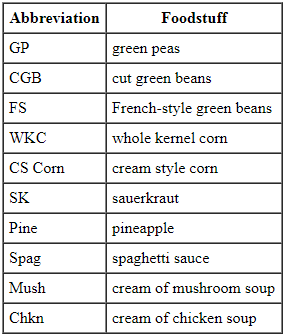
Big Food Storage Challenge: Raw Eggs
The most aggravating food storage situation we have ever encountered concerns raw eggs inside our ice chest.
While the styrofoam trays that some eggs are sold in can provide decent protection for awhile, they can come open inside the chest.
Eggs cannot be stored on ice inside paperboard trays (because the trays will get wet and provide no protection at all).
We had some success packing 6-8 eggs between paper towels inside empty glass canning jars, but there was so much wasted room that we pursued other options.
 We had absolutely disastrous results packing them inside the little egg carriers that campers take on trips, even when we tried putting cushioning inside.
We had absolutely disastrous results packing them inside the little egg carriers that campers take on trips, even when we tried putting cushioning inside.
For that reason, we have drawn a null symbol over such a carrier, as shown here.
We finally hit upon a food storage solution that worked well consistently for raw eggs: using a medium-sized lidded storage bin and cloth dishcloths for cushioning.
If two dozen eggs were purchased at a time, we could
- stand about 9 eggs on top of a dish towel on the bottom layer;
- stand another 9 eggs on top of a second dish towel on the second layer (alternating them on top of the first layer); and
- lay the remaining 6 eggs on top of a third dish towel, wrapping it over to prevent breakage from the lid.
Occasionally, it is more convenient when baking to use a starch-based egg substitute instead of an actual raw egg.
For times like this, we have used Ener-G Egg Replacer, as shown here, which requires no refrigeration. (Caution: this product is not to be substituted when the main ingredient in the dish is eggs.)
We purchased our box of egg replacement powder at a local health food store.
Disclaimer: Because this product is a starch, we have learned from experience that it will “stuck like mad” on our waffle iron or electric skillet. For that reason, we don’t use it in pancake or waffle mixes.
Bread and Baked Goods
For awhile, when we ate bread that was baked in square loaves, we used a Buddeez Sandwich Size Bread Buddy Dispenser, which served a two-fold purpose:
- sealing the loaf and
- preventing the loaf from being crushed in transit.
The disadvantage of using one of these food storage containers is that as the bread wrapper is pulled from the inside around the outside (to dispense bread one slice at a time), any crumbs that cling to the wrapper will be brought outside the container and eventually fall off, necessitating extra cleaning.
For a while, we chose to eat bread that was baked in wider loaves. We left the loaves in their original bags and made sure they didn’t get crushed.
Fresh Fruits and Vegetables
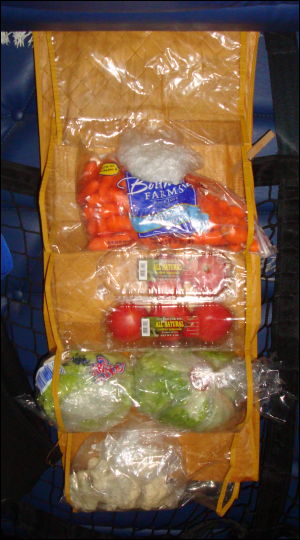 We have tried numerous methods of storing fresh fruits and vegetables in our truck.
We have tried numerous methods of storing fresh fruits and vegetables in our truck.
At one point, we tried storing vegetables in an old shoe organizer on the back wall, as shown here.
It didn’t work very well for a number of reasons, primarily because larger vegetables like lettuce and cauliflower couldn’t fit in the sleeves.
The lettuce shown here are smaller heads and the cauliflower cut up.
Also, we found that besides bananas, onions and potatoes, the majority of fresh fruits and vegetables need to be kept cool or cold.
Tomatoes, green peppers and cucumbers tend to go to mush pretty quickly if stored in plastic bags, even Green Bags and even if stored in a cool place.
Dehydrated and Freeze-Dried Foods
A perfect place to store dehydrated and freeze-dried foods is in a sealed, preferably oxygen-deficient, container or bag that is kept cool.
We kept ours below the lower bunk.
Liquids
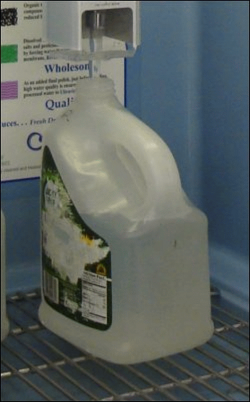 Before Vicki joined Mike in the truck in 2009, he typically carried 6 gallons of water with him for drinking and cooking.
Before Vicki joined Mike in the truck in 2009, he typically carried 6 gallons of water with him for drinking and cooking.
When Vicki joined him, we increased the number of gallons of water that we took with us. (It increased even more when we started making our own ice.)
We noticed that the gallon-sized containers that water is sold in at many American grocery stores are quite flimsy.
So, we “invested” in sturdier jugs, such as those which are used for storing apple juice.
It must be noted that all containers like these must be thoroughly cleaned prior to repurposing.
After changing jugs, we didn’t have to worry about the integrity of the plastic when we refilled them at water vending machines.
We tried for awhile carrying a certain brand of popcorn popping oil but the seal on the container was not good and it spilled more than we liked.
So we took that out of the truck.
On the other hand, we always carried olive oil for cooking (especially for boiling pasta and making waffles).
Sometimes we would transfer the oil to a different bottle, sometimes not.
The best success we had in keeping it upright was to store it on the floor between the portable toilet and the lower bunk, wedging it close to the cabinet behind the toilet with other items that would not move.
Conclusion
When a long haul trucker goes on the road for days, weeks or months at a time, he/she may not know how long it will take until he/she can get to a grocery store.
Instead of continually depending on restaurants or obtaining some fresh things from the refrigerated sections of truck stops or convenience stores, there are some foodstuffs that you can take with you in your truck to make nutritious and filling meals.
The proper food storage system and containers can help you keep certain foods in your truck to help you save a lot of money over time.
![]() Money saving tip: Some people prefer to buy new off-brand plastic food storage containers from discount stores.
Money saving tip: Some people prefer to buy new off-brand plastic food storage containers from discount stores.
Others prefer to buy pre-owned units at thrift or re-sale stores.
If you opt for the pre-owned versions, just make sure that the bowls and lids fit each other.
Occasionally, you can find coupons for name brand plastic food storage containers in the Sunday newspaper.
There are also online coupon sites where you may be able to find them.
There are differences in thicknesses of resealable plastic bags.
“Freezer” bags have thicker walls than regular storage bags.
Some bags have double seals which help prevent leaks of air or liquids.
Foods should be rotated and consumed according to age as there is a definite shelf-life to even non-perishable foods.
Fresh foods should be eaten in a timely manner so as to prevent spoiling (and waste).
Some people are concerned about the ability to use storage containers in a number of settings such as refrigerator, freezer and microwave oven.
Be aware that in some settings, plastic may not hold up well or may release chemicals into the food stored within.
If this is a concern of yours, perhaps you should consider storing your food in other types of containers such as glass.
Beware of storing any kind of acidic food like tomatoes in a metal container.
We list food storage containers and bags on our shopping list, which you may obtain from our Free Downloads page.
Return from Food Storage Ideas for Truckers Living in Tractor Trailers to our Meal Preparation page or our Truck Drivers Money Saving Tips home page.









